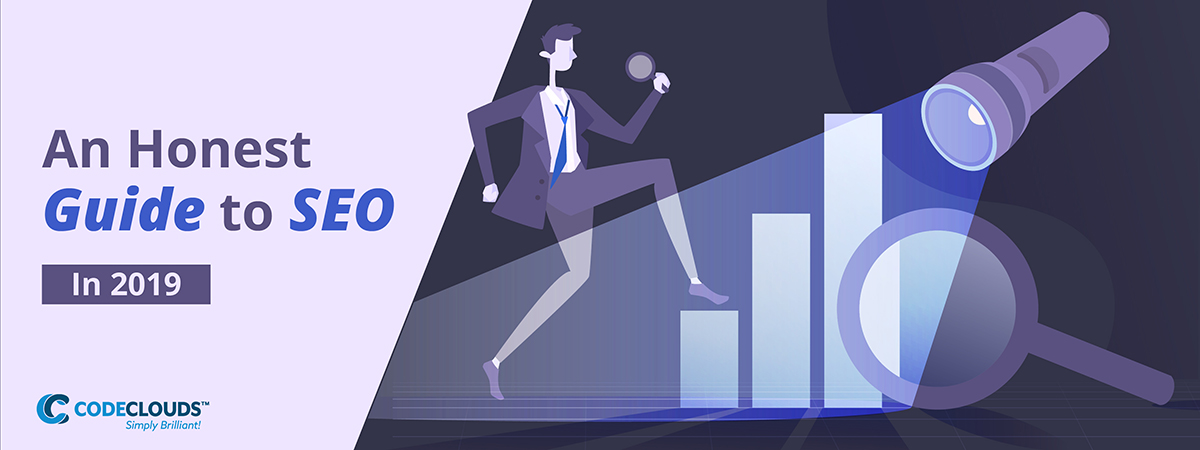Overview
It has been a big couple of years for the SEO industry, and a lot of marketers are struggling to keep on their feet. As Google gets better at reading user intent, old techniques die off and new methods need to be discovered to keep on top. SEO used to be about tips and tricks, but now it’s more about tools, knowledge, and writing content people want to read. How can you get the most out of your SEO in 2019?

Load Times, Load Times, Load Times
We talk a lot about web speed optimization here at CodeClouds, but that’s because it’s so important for your SEO. As we’ve discussed previously, slow load times affect conversion rate and can tank your SEO. Slow load times mean more bounces, and more bounces means your rank will slip. How badly? Well, 53% of users leave a site that hasn’t loaded within 3 seconds. While many sites have made significant advances in the last two years, there’s still a long way to go before the average load time is anywhere near acceptable for the modern user. If you want to know what you can do to get on top of this, check out our article on web speed optimization.
How we Measure Page Speed is Changing
Something new to keep in mind is the Chrome User Experience report. It has been around for a while, but started influencing SEO in 2018 and many still haven’t caught on. Google used to measure your site’s speed based entirely on on-site technical factors, but they now include aggregate data based on how (Chrome) users actually interact with your site. If it works fine on your computer and on Google’s but crashes constantly on a specific brand of phone in Indonesia, that hurts your SER. Learn about how the CUE works and start considering it in your SEO strategy going forward.
M-dot Pages Have Gone the Way of the Dinosaurs
You need to move away from M-dot pages and you need to have done it yesterday. With the last few years’ big focus on mobile-first indexing, the antiquated m-dot page (where you have separate mobile and desktop pages, and the users get redirected based on the specs of their device) will hurt your SEO even more than it used to. Google doesn’t like redirects, and users don’t like sites that look like they’re from 2011. If you haven’t already, you need to look into responsive CSS pages—that’s when you have a single page that changes depending on the device it’s being viewed on. It’s easier for both users and crawlers to navigate, and you should see a big bump if you make the switch.
Write Better Titles (to maximize your SEO)
Hubspot did a very interesting report on titles and CTR that has one titling trick I never really saw adopted outside of the occasional site like Cracked: parentheses. Hubspot founds that titles that include a subtitle in brackets saw a significant uptick in clickthroughs:
“Headlines that ended with bracketed clarifications performed 14% better than headlines without such clarifications, showing that readers are not only more likely to click when they have a clear picture of what lies behind the headline, but are also more likely to stay engaged.”
This also lets you get more detail (and keywords!) into your titles without making them seem bloated. Keep in mind, this should be informative. I’ve seen SEO marketers try to use this to write titles like One Weird Trick (that actually works!), but ‘actually working’ doesn’t provide the user any clarification. It’s redundant, and rooted in an old way of writing titles that proved deeply unpopular with users. A bracketed subtitle is a way to generate organic clickthroughs by telling the user that your piece of information is the specific one they want, not merely to tell them that it’s good.
The report also goes into that sort of redundant puffery: overuse of superlatives (e.g. One Amazing Trick That Will Absolutely Positively Blow Your Mind: It Really is Very Hilarious and Truly Wonderful) is a huge factor in users ignoring your site. Everybody says their content is good, and so doing it does nothing to distinguish you from the pack; and we know many of them are lying. It’s a harsh truth, but users don’t believe the hype. Your title should be honest, direct, and useful.
Get on Google Correlate
Edit: Google Correlate was shutdown on December, 15th, 2019.
Google Correlate is a handy and underutilised tool for keyword planning. It’s essentially Google Trends, flipped upside-down—it’ll supply you with terms that searched for in clusters around your own, grouped by time. It lets you find keyword data patterns that often seem obvious in hindsight, but never occurred to you before you saw them laid out.
Google Correlate is a handy and underutilised tool for keyword planning. It’s essentially Google Trends, flipped upside-down—it’ll supply you with terms that searched for in clusters around your own, grouped by time. It lets you find keyword data patterns that often seem obvious in hindsight, but never occurred to you before you saw them laid out.
.png?updated_at=2023-07-26T09:55:48.382Z)
This can give you a huge competitive edge if you plan your keywords in clusters. Some might seem obvious (people searching for gloves then search “mens leather gloves”) but be honest: were you expecting to see car starter installation with a 94% correlation? Did you think about running gloves? Obvious in hindsight, but probably not something you’d consider if you were planning your keywords without Google Correlate.
I will say: correlation is not causation. It’s a bit of a cliche, but it’s important to keep in mind. Why are car starter installations and gloves correlated? Probably because starter motors can break down in cold weather, which is exactly when people are buying gloves. Unless you’ve got a plan to sell fleece-lined mechanics’ gloves, it’s not very useful to you; Correlate is a powerful tool, but one you should use with discernment.
Bite Into the Snack Pack (Your Business Listing Matters)
Do you know what a snack pack is? We’ve talked about the Google SEO snack pack before at CodeClouds: it’s the top-3 selection of local results that show up when somebody searches for a particular sort of store in their area. It looks like this:
.png?updated_at=2023-07-26T09:55:52.816Z)
And, as we discussed in that article, your Google Business Listing is the single most important factor to getting your business in the snack pack. Making sure it’s correctly configured will give you a huge bump in visibility and CTR, giving you that all-important organic traffic. If you want to find out what other factors go into getting yourself listed in the top three, check out our guide to the Google SEO 3-pack.
Share the Love!
Google likes sites who use outbound links well. If you’re referencing somebody (particularly somebody authoritative, who Google likes), then linking back to them will give you authority. It’s important to only do this when it’s actually relevant: spam sites have tried to abuse this and if you overuse outbound links, Google will mark it down as suspicious and it can result in a penalty. In the bad old days of SEO it was often about finding one technique and grinding it down into the ground, but SEO in 2019 is more about striking the right balance and using techniques only when it would be a natural fit to use them. To succeed in today’s environment, be good, be honest, and give credit where it’s due.
Good Content Isn’t Good Enough
SEO Luminary Rand Fishkin (of Moz fame) coined the term 10x Content to refer to content that wasn’t just good, it was ten times better than the next thing down the SERP. Which at first seems like he’s just saying “good content” but on examination it goes deeper than that—for content to move up the rankings, it can’t just be good. Good is not good enough. Maybe it was enough 10 years ago, but we’re at a point where you need to be aiming for more than good: you need to be aiming for perfect. You need to be aiming for 10x.
This sometimes means delaying content releases to make sure things are as good as they can be. You might want to invest heavily in content management, and make the content the main thrust of everything you do. People say ‘content is king’ but they don’t really examine what that means, and Fishkin laid it out about as clearly as you’re going to ever see: your content must be 10 times better than the next thing down.
10x also means making sure the user experience is as polished as it can possibly be. Content doesn’t exist in a vacuum: the best content in the world isn’t going to work if it looks like a teenager’s MySpace page from 2006. The user needs to come away from your site with a positive experience, and an active desire to come back.
Cut off Your Long Tails
As RankBrain takes over handling of the Google Algorithm, we’re seeing longtail keywords become less and less relevant. That’s because RankBrain is less about specific wording than it is about intent. Remember Latent Semantic Indexing? It’s an old school search engine concept that stuck around in SEO for years after it stopped being relevant to Google, but it’s made a strange sort of comeback. RankBrain isn’t LSI, but it’s useful to think about it in similar terms—your rank is calculated partly based on words like your keywords, rather than on your specific keywords. RankBrain is significantly more advanced than LSI was: it’s a machine-learning algorithm that calculates the like-ness of words based on user behaviour. If people searching for “gloves” are all clicking on the same style of men’s brown leather glove, then RankBrain is going to understand that ‘men’s brown leather’ is an associated keyword string and attach it to your keyword for you.
You Should Be Dating Your Content
Not adding a timestamp is a grey-hat technique that needs to die. The current year is a huge search term, but a lot of sites still neglect to tell you when content was written. Some marketers I’ve spoken to claim that not having a date makes content timeless, but I disagree: it makes content useless. Tech moves fast, and what you’re going to get if you have outdated content with no timestamp is low dwell/high bounce, because readers will figure it out as soon as they stumble on a reference to something outdated. You can try to avoid it, but unless you’ve got a crystal ball you’re eventually going to get something wrong. When you inevitably slip up, users will notice and will no longer trust your site, and you’re killing your own CTRs.
We’ve all been there while doing research, and Google is getting smarter—it knows when users are leaving a page, and if they’re giving up partway through your content then you’re going to take an SEO hit.
“But what happens when the year is up?”
Firstly, a 2019 guide doesn’t stop being relevant on January 1st of the next year and secondly: when it becomes outdated, write a new guide. Yes it’s work, but it’s also going to get you a huge upswing in users and engagement. If not much has changed, find out what has changed, then edit and update last year’s one.
Put Away Your Grey Hat
Which leads onto my next point: Google is smarter than ever. SEO was a wild west for a long time, but Google has been laying down railroads and now the place is almost civilized. All of the good SEO tips and tricks in our current day and age boil down to this: make content users want, and put it forward in ways users like. Cowboy SEO has no place any more, and if you’re still running off your old tricks from 2010 then you’re running yourself into the ground. If you’re running off your old tricks from 2016, you’re probably still running yourself into the ground.

And that’s it, in a nutshell. I feel like I’m banging a drum, but it’s important for our community to hear: things have changed. SEO isn’t for cowboys any more: it’s about understanding your technologies and tools, and producing the sort of content users want.
Share this article
375 reads
Similar Reads








